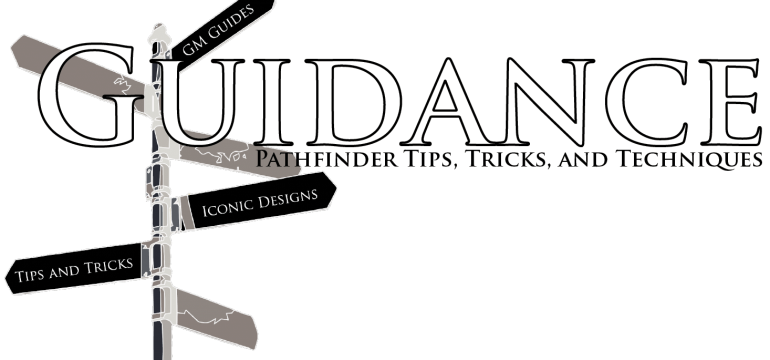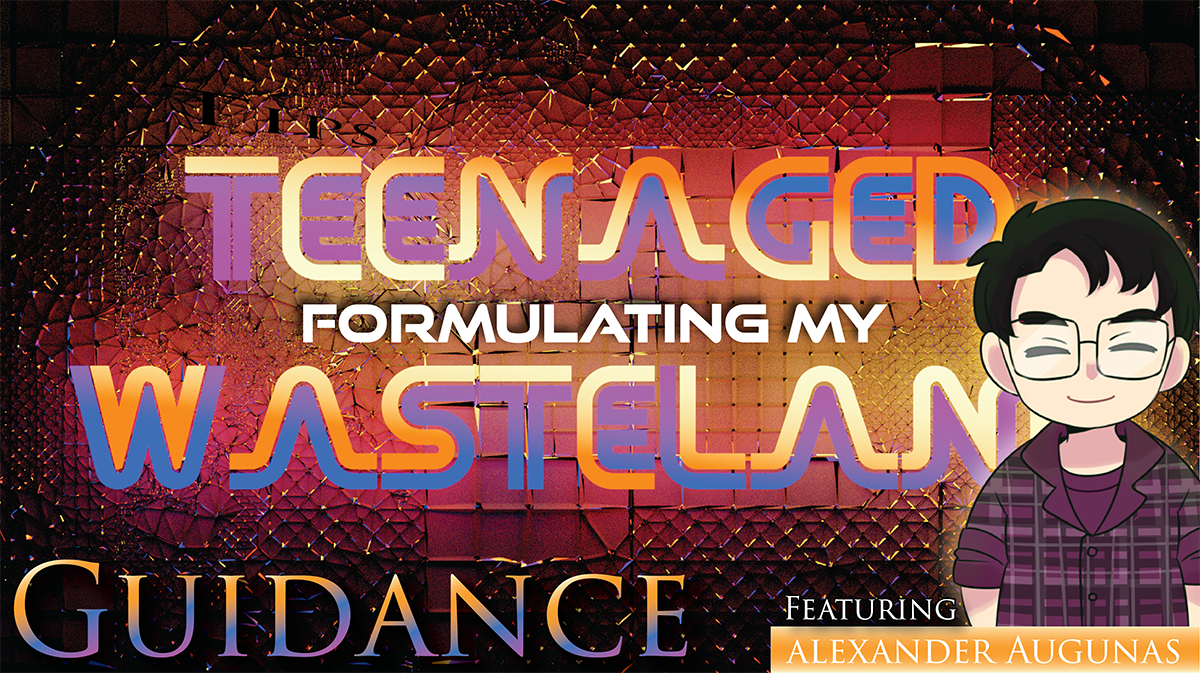Hello, everyone, and welcome to Guidance! I’m fresh from my week off thanks to our annual Know Direction guest blogger take over week, and ready to get back to offering you some helpful Guidance! About two weeks ago, I was chatting with friend and fellow Know Direction blogger about Starfinder and why it’s frankly my favorite Tabletop RPG from Paizo. Dustin disagreed; he prefers Pathfinder Second Edition. Now, I’m not saying that Dustin’ll turn around and agree with me that Starfinder’s got a more player-rewarding mathematical system than Pathfinder does, or that Starfinder’s classes are more open in what you can do with them, or that Starfinder has a better diversity of character builds, but one thing that I quickly realized as we were talking—Dustin made a TON of mistakes about Starfinder rules. So finally, I asked him outright.
Alex: “Dustin … have you ever PLAYED Starfinder?”
Dustin: “Yes! Once. At GenCon. The year it came out. In a 1-hour quest. What? Why are you looking at me like that?”

Designing a Homebrew Campaign in 2020
Now, I’m not gonna lie. My homebrew game is the first campaign that I’ve run that wasn’t an Adventure Path since 2015, easy. It’s been a LONG time. So I wanted to make sure I did things right. Or at least, right by me.
1. Gather Players
For me, the most important part about designing any campaign is making sure that you have players to play in it. This was pretty easy for me; I’m an officer for a Horde guild in World of Warcraft, and I had a bunch of friends that I raided with and did dungeons with that I knew played Tabletop RPGs and would be interested in an online game of Starfinder. I decided pretty early on that I was going to have a fairly large group—I offered player spots to a total of seven players including Dustin. It’s a lot, but it’s not unmanageable in Starfinder, with its lower-tier magic system and it’s relatively simpler action economy. Compared to both editions of Pathfinder, after all, Starfinder is much more about modifying and improving the game’s basic actions than adding oodles of new actions to the list of things you can do. Plus, you know, I helped write most of the biggest Starfinder books that are out so far, and all but one of my players has experience playing D&D 5E or Pathfinder 1E. I was confident that I could handle teaching them the game, and four weeks later I’m still confident that I can teach them the game.
2. Pick a Setting
Once you have the players assembled, I think that the next most important task is actually choosing a world for your game to take place in. When you’re doing this, you can generally go one of two directions—you can design the setting yourself or you can use a preexisting setting. I, of course, am extremely difficult and did both of those things. I used an established campaign setting that I am one of the primary authors of, the Blood Space campaign setting, by Rogue Genius Games and Everybody Games. I had just finished writing and publishing Blood Space Gazetteer: The Radiant Imperium when I got the itch to run a new campaign, so I decided immediately that I was going to set my game in Blood Space, using a lot of the new lore that I wrote specifically for the Radiant Imperium.
When you’re talking about Starfinder, though, you also need to pick a “scope” for your setting, in that you need to know whether your campaign is grounded in a specific location or whether you’re travelling all around the galaxy. From what I’ve seen Starfinder Adventure Paths tend to do more of the traveling; so far I’ve completed Dead Suns, have played a good chunk of Book 1 of Against the Aeon Throne on Stellar, and I’m nearing the end of Signal of Screams in a home game, and all of those adventures change which planet you’re on from book to book. I didn’t want that, in part because I haven’t published fully fleshed out gazetteers for every planet in the Blood Space campaign setting yet, but also because I’m dealing with new players and I want them to feel like the places they’re going to matter. This is a personal preference, but I find it’s really tough to connect with the places you’re going to in adventures that have you constantly moving around, especially when the places you’re going to aren’t well foreshadowed. I think it’s one of the reasons Kingmaker remains one of Paizo’s most popular adventure paths to date; you’re building a place, which means you’re building a connection to that place. It’s a powerful thing.
With all those ideas swirling around in my head, I decided that i wanted to set my game on the planet Tor in the Blood Space campaign setting’s Xa-Osoro System. I was going to allow characters and story beats from the Pact Worlds and the Veskarium if the players expressed interest in using them for their characters’ backstories, but I wasn’t going to involve either system in the campaign at all beyond lip service. The campaign would stay in the Radiant Imperium and use Tor as a base of operations of sorts. Now, with this as the limiting factor, I needed to come up with a reason why the players couldn’t just up and leave Tor. At least, not at first. Ultimately, I decided on a high school campaign, which brought me to my next task:
3. Pick a Tone
When you’re designing a campaign, an effective tone is critical. What’s the campaign going to be about? Obviously having a game about a group of high schools using a system that’s largely based around combat means one of two things: I was going to need to go out of my way to make sure that the players weren’t in any real danger, or I was going to need to go DARK. In order to do this, I drew on some of my favorite media involving Starfinder and high school.
- My Hero Academia is an anime about a bunch of kids with super powers going to school to be super heroes. One of the things I love about My Hero Academic is that the show really goes out of its way to give you time to get to know its main, secondary, and tertiary characters. I wanted a game where the people that my players interacted with mattered, so My Hero Academia was a real influence for me. I also really liked the idea of, “These kids are the best of the best, and as a result they have more privilege than ordinary kids would have,” as an explanation as to why my PCs would have powerful weapons and/or a starship.
- Ender’s Game is a book about a boy who gets enlisted into a military school. He’s super bright and smart, but in the game he becomes a military pawn for the government and commits some real heinous atrocities. One of the things I really liked about Ender’s Game is the idea of the kids having to routinely practice military drills and exercises against each other; that seemed like something the Radiant Imperium would want its young cadets to do.
- Kill La Kill is an anime about a high school that basically serves as the fascist government for an entire community of people. Kill La Kill is a really good anime despite its raunchiness, but what I really liked about Kill La Kill for this game is the idea that the kids would have a pecking order in the school, and maybe that pecking order meant something to the society beyond it. I didn’t want to go to the Trigger levels of extreme that are shown in Kill La Kill, but the idea that the kids have status for being at a prestigious military school was something I really liked.
- God of High School is basically an anime that’s all about a fighting tournament arc. It’s really gonzo, over-the-top action along the lines of Dragonball Z or Bleach, but it’s really grounded in the characters’ motivations alongside a really interesting subplot. I liked God of High School for its escalation; the kids were always strong, but in a short period of time things really get out of hand. Kill La Kill is like this too, and I think that as the story goes on I want it to explode in its escalation.
- Fruits Basket is a slice of life anime that’s all about kids being kids in High School while unraveling a supernatural plot. To be honest, I don’t think that the supernatural elements of Fruits Basket have gotten the attention they serve in Seasons 1 and 2, and that’s something I’d like to do better with in my campaign. However, the idea of a story that unfolds based on the characters that the players interact with and how well they like those people really appeals to me; dumb action is fun, but in my experience what makes a campaign a legend to its players is the emotional connection that’s established between players and the world, and Fruits Basket does this REALLY well.
So with this in mind, my tone is definitely an action-heavy series with a strong emphasis on slice of life roleplaying to further the plot and the action.
4. Know What You’re NOT Using
Oftentimes your campaign can be defined as much by what you choose to exclude from your influences as what you are purposefully omitting, because that helps you focus your game.
- Harry Potter is, like the #1 thing people expect me to base my game on the minute I say, “It’s about high school kids!” I’m not really interested in doing things like houses, which I feel replace interesting character dynamics with stereotypes about the people who belong to said house, or OP all-powerful baddies like Voldemort. Moreover, the story really focuses on Harry in Harry Potter, which makes sense I guess, but there shouldn’t be one main character in a tabletop RPG. Also, RK Rowling is a huge trans-exclusionary radical feminist and I refuse to let myself consciously draw upon the work of someone who actively hurts transfolx.
- Star Wars / Star Trek / Firefly are basically the biggest, most used properties when it comes to science fantasy, and honestly? Meh. Like, they’re not BAD, but they feature space stuff so prominently that I kinda don’t really need them. Plus starship heavy games for teenagers in high school feels weird.
Looking Forward
I’m planning to talk more about Teenaged Wasteland in the future, particularly about how I’m using limitations imposed by the pandemic in order to enrage the engagement of my players. In my next article, I’m going to talk about my use of Discord and how I’ve been using that to promote the slice-of-life style storytelling I set out for as one of my major tones for the campaign, and I also want to talk a bit about communication with players and the weaving of stories together into a whole. Oh, and I also want to talk about NPC portrayal. So yeah, plenty of things to talk about! But we’ll worry about that next time, on Guidance!

The sick Teenaged Wasteland banner was made by one of my players as the banner for the Teenaged Wasteland Roll 20 game. He gave me permission to use the banner for my articles, but wishes to remain anonymous, so we’ll call him Witch. Thank you so much for letting me use this, Witch!






